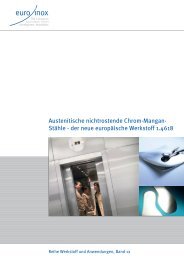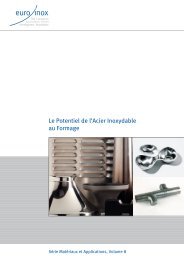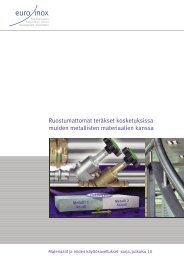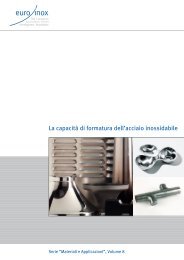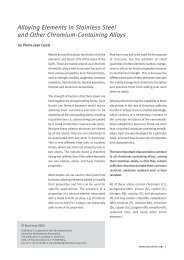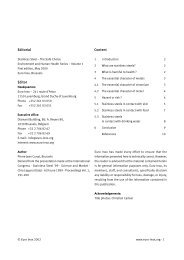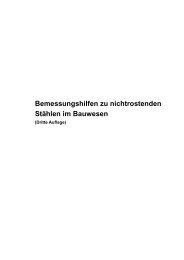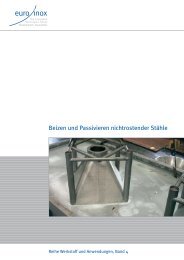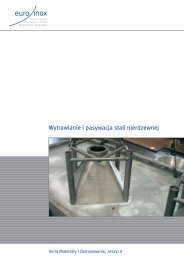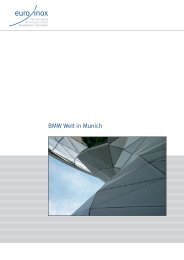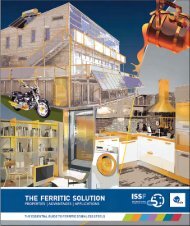Innovative Stainless Steel Applications in transport ... - Euro Inox
Innovative Stainless Steel Applications in transport ... - Euro Inox
Innovative Stainless Steel Applications in transport ... - Euro Inox
Create successful ePaper yourself
Turn your PDF publications into a flip-book with our unique Google optimized e-Paper software.
performance of a weld-jo<strong>in</strong>t detail (Hobbacher 2007). To simplify, FAT is the fatigue<br />
strength at 2 million cycles. Both mean FAT50% (i.e. 50 % confidence) and characteristic<br />
FAT95% (i.e. 95 % confidence) values are used. FAT values are listed for a number of<br />
jo<strong>in</strong>t-type cases made of C-Mn steel or alum<strong>in</strong>ium. No direct data is given for sta<strong>in</strong>less<br />
steel, but C-Mn steel cases are often also used for sta<strong>in</strong>less.<br />
For the jo<strong>in</strong>t type tested by Huhtala (2008), IIW cases nos. 214 or 215 can be used.<br />
Accord<strong>in</strong>g to Hobbacher (2007), the characteristic FAT95% is 80 and 71 N/mm 2 for cases<br />
214 and 215 respectively. The results from Huihtala (2008) are shown <strong>in</strong> Table 32. Apart<br />
from conventional fatigue test<strong>in</strong>g <strong>in</strong> air, further reference tests were carried out <strong>in</strong> both<br />
air and NaCl-environments for ferritic sta<strong>in</strong>less steel 1.4003 welded with 308L filler<br />
material.<br />
Table 32. Fatigue and corrosion-fatigue test results for 3 mm sta<strong>in</strong>less steel base materials and<br />
their butt jo<strong>in</strong>ts (Huhtala 2008). B = arc braz<strong>in</strong>g, U = ultrasonic treatment, G = grit blast<strong>in</strong>g,<br />
BM = base material.<br />
Material &<br />
Environment<br />
FAT Remarks<br />
BM MAG Laser<br />
FAT50 % FAT95 % FAT50 % FAT95 % FAT50 % FAT95 %<br />
1.4301 air 261 200 154 105 180 108<br />
NaCl - - 147 71 152 52<br />
1.4318 air 311 280 137 92 - -<br />
NaCl - - - - - -<br />
1.4318B air - - 127 114 - - arc brazed<br />
1.4318 air - - 131 105 - - all samples<br />
1.4318U - - 138 98 - - UT root<br />
1.4318G - - 124 110 - - grit blast root<br />
1.4003<br />
air 281 261 152 131 - -<br />
NaCl - - 161 105 - -<br />
It can be concluded from the results that the IIW recommendations are easily exceeded<br />
with all the tested materials, weld<strong>in</strong>g methods and filler materials, <strong>in</strong>clud<strong>in</strong>g the silicon<br />
bronze CuSi3 used for arc braz<strong>in</strong>g. The ultrasonic or grit blast<strong>in</strong>g post-weld treatments<br />
<strong>in</strong>creased fatigue performance slightly but the highest FAT value for 1.4318 material<br />
was achieved with arc braz<strong>in</strong>g. This was probably due to the smooth top and root<br />
re<strong>in</strong>forcement geometry typical of an arc-brazed jo<strong>in</strong>t, which is favourable from a<br />
fatigue po<strong>in</strong>t of view. A limited number of corrosion-fatigue tests were carried out for<br />
these materials but it does appear that the NaCl environment has a negative effect on<br />
fatigue strength. Nevertheless, accord<strong>in</strong>g to these results, the jo<strong>in</strong>ts (except perhaps the<br />
laser-welded jo<strong>in</strong>ts) still meet the IIW requirements.<br />
95



